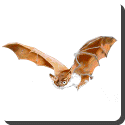 Bat — A bat is a mammal in the order Chiroptera. Their most distinguishing feature is that their forelimbs are developed as wings, making them the only mammals in the world naturally capable of flight (though other mammals, such as flying squirrels, gliding flying possums and colugos, can glide for limited distances). The word Chiroptera comes from the Greek words cheir “hand” and pteron “wing,” as the structure of the open wing is very similar to an outspread human hand with a membrane (patagium) between the fingers that also stretches between hand and body.
Bat — A bat is a mammal in the order Chiroptera. Their most distinguishing feature is that their forelimbs are developed as wings, making them the only mammals in the world naturally capable of flight (though other mammals, such as flying squirrels, gliding flying possums and colugos, can glide for limited distances). The word Chiroptera comes from the Greek words cheir “hand” and pteron “wing,” as the structure of the open wing is very similar to an outspread human hand with a membrane (patagium) between the fingers that also stretches between hand and body.
There are estimated to be about 1,100 species of bats worldwide, accounting for about 20 percent of all mammal species. About 70 percent of bats are insectivores. Of the remainder, most feed on fruits and their juices. Only three species sustain themselves with blood, some preying on vertebrates: these include the leaf-nosed bats (Phyllostomidae) of Central America and South America, and the two bulldog bat (Noctilionidae) species, which feed on fish. At least two species of bat are known to feed on other bats: the Spectral Bat, also called the American False Vampire bat, and the Ghost Bat of Australia. One species, the Greater Noctule bat, is believed to catch and eat small birds in the air. Bats are present throughout most of the world; despite the cold weather, there are six species of bats in Alaska.
Some of the smaller bat species are important pollinators of some tropical flowers. Indeed, many tropical plants are now found to be totally dependent on them, not just for pollination, but for spreading their seeds by eating the resulting fruits. This role explains environmental concerns when a bat is introduced in a new setting. Tenerife provides a recent example with the introduction of the Egyptian fruit bat.
Bats can also be in the superorder Archonta.
 Kids Portal For Parents India Kids Network
Kids Portal For Parents India Kids Network






